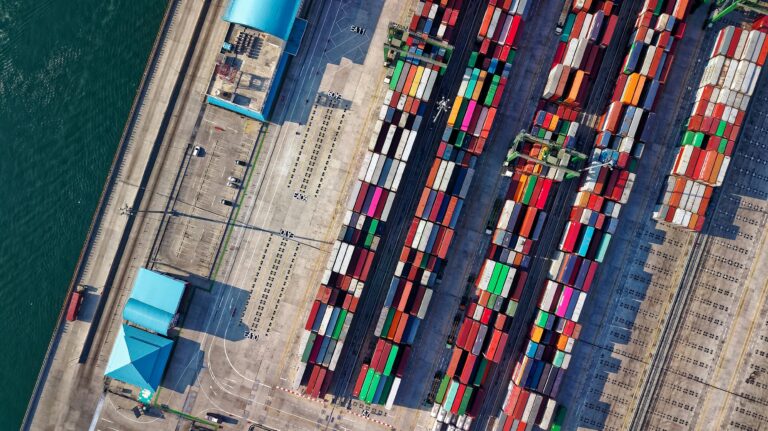In that era where digitalization is revamping industries, the fintech development companies have a role in transforming supply chain management has become the pivotal. These entities stand at the forefront of an evolving landscape, driving efficiency and innovation. Yes, the journey to digitalized supply chain transfiguration from an ordinary one is complex but rewarding due to the added enhanced transparency, speed, and flexibility. This article discusses key steps and contemplations necessary towards digital transformation of a supply chain and throws the most important message that fintech plays the pivotal role in such a journey.
Key Technologies Driving Digital Transformation

Artificial Intelligence (AI): AI revolutionizes supply chain operations using augmented predictive analytics, demand forecasting, and automation. AI-powered tools can use predictive analytics to analyze big datasets to cull the necessary trends in order to take enlightened decisions such as maximizing the routes for logistics or making exact predictions of future inventory requirements.
Internet of Things (IoT): It is through IoT that the supply chain activity gets monitoring and managing from real-time. Sensors can be used to track conditions of a product when transporting, which then ensures quality and compliance, as well as visibility through real-time location in the RFIDs thus better inventory management.
Blockchain: The blockchain technology provides a safe and secure, unchangeable record for the recording of transactions and insures data integrity and trust in the supply chain. It enables a clear record keeping from production to delivery hence assures accountability in the process to ensure efficiency.
Overcoming Challenges in Digital Transformation

A number of challenges that the fintech development companies and those responsible for the supply chain will have to sail through delicately are a part of this process of transformation.
Stakeholders Engagement
In most cases, the success of digital transformation initiatives often rest on engagement to be seen from all stakeholders. This does not only stop at the internal teams but also reaches out to partners like suppliers, distributors, and customers. To effectively engage your stakeholders:
- Communicate: Articulate the vision, objectives, and benefits of the change clearly to all key stakeholder groups. Provide regular updates and foster dialogues through open channels for feedback that enable a sense of ownership among teams.
- Training and support: Provide extensive training and support to the stakeholders with acclimatizing the new technologies and processes. This becomes important for reducing resistance and ensuring a smooth adoption process.
- Collaborative Approach: Include the stakeholders even in the planning and stages of implementation as well. The ideas which are being shared by them could significantly be more effective in transforming and modifying the process of transformation more aptly.
Rigorous Testing
Certain aspects need to be taken care of, as the integration of the new digital instruments should be profitable for the business:
- Pilot Programs: Pilot new technologies in a controlled environment, implementing pilot programs or phased rollouts. This will allow bugs or issues to be found and corrected before large-scale rollout.
- Performance Monitoring: Define metrics to ascertain the performance of new systems against estimated numbers in terms of result values. Continuous monitoring can help to identify any imbalances with ease.
- Feedback Loops: Create systems or processes which will be constantly feedback from users over technology and process improvement and refines the same.
Continuous Learning and Adaptation
Digital transformation is not an event but a continuous journey:
- Innovation Culture: Create a culture to foster innovation, experimentation, and learning. Encourage employees to look out for new ideas and technology.
- Keep Pace with Trends: Stay updated on the upcoming technologies and industry trends. Regular training sessions and workshops can keep teams at par.
- Agile Methodology: Go in for agile methodologies which allow the flexibility and quick adaptations to changes in technology and market demands.
Measuring Success in Digital Transformation

Hence, proper measurement of the success, in terms of its impact and as a yardstick for future strategies is necessary.
Operational Efficiency
- Process Optimization: Watch out for improvements in process times and operational workflows. Metrics would include lower lead times, higher accuracy in demand forecasting, and cleaner logistics.
- Cost Saving: Measure the cost savings achieved through digital transformation. For instance, labor costs reduction, reducing inventory holding cost, or wastage.
- Throughput Improvement: Measure improvements in throughput rates such as reduced delivery lead-times and increased production capacity.
Customer-Side
- Feedback and Ratings: Continually gather and occasionally examine feedback from the customers. They could be either through survey reports or online reviews or otherwise direct conversations with the customer.
- Retention and Loyalty: Track customer retention rates together with loyalty measures. Attaining repeat business as well as getting referrals might indicate that digital transformation is paying off in terms of customer satisfaction.
- Service Quality: Measure the service quality improvements viz lower delivery time, better product quality and improved customer service.
Digital Integration Levels
- Technology Adoption: Measure the degree of adoption of various new digital tools and platforms within the organization.
- Integration with Current Systems: The degree of integration of new digital offerings with the current level of systems and ways of doing things.
- Employee Adaptation: The speed or effectiveness with which employees adapt, respond to, and adopt digital tools and workflows.
Integrating Digital Solutions: A Step-by-Step Approach

Therefore, properly integrating digital solutions into supply chains in a way that enhances its rather than hampering performance of the supply chains is a nuanced and strategic process that is necessary to ensure competitiveness of businesses through loosely competing as well as cooperating in the rapidly changing digital environment. Sufficient integration calls for a meticulous and methodical approach to actually implementing such systems that are also adaptable and focused on achieving long-term success.
Assessment
The first critical step is the profound assessment of existent supply chain processes. At this stage, a deep analysis will be needed to identify areas that digitalization is supposed to have the best impact. This is not only to identify the weak links in the chain but to understand the flow of operations, right from procurement until the delivery. The new technology alignment with the company’s broad goals and objectives should as well be a part of the assessment. For example, if a company is looking forward to reduce their carbon footfall, technologies that optimize the predetermined route with minimum fuel consumption will be the focus area.
Development of Strategy
After assessment, next in line is the development of the unique strategy for the digital intervention. This strategic vision has to go beyond just a roadmap, it must be the vision of how digital transformation is going to reshape this supply chain. It entails choosing the right technologies such as AI, blockchain, or IoT and what implementations they will have on existing processes. The strategy should also consider the human factor – how employees are going to work with new systems and how this change will affect a company’s culture. It’s about developing a digital ecology that is sustainable, efficient, and future-competent.
Implementation
The implementation is all about getting the strategy done. This phase is classified as a digital solutions phased roll out whereby a staggered approach ensures that each milestone is taken cautiously with careful monitoring and typically minimises disruption to normal day-to-day business as usual operations. So it’s not unusual to start with a pilot program, dipping the toe in the water with a small slice of the supply chain before scaling up. This process also has to be about flexibility and adaptability – being ready to pivot as stumbling blocks arise while new opportunities crop up.
Monitoring with Refinement
Last, but not least, the process of integrating digital solutions is actually never complete. The last stage involves a constant cycle of monitoring and refinement. There should be in place a constant revisiting to ensure that digital solutions are actually luring. It basically involves tracking all the key performance indicators, taking feedback from the stakeholders and making the adjustments that are necessary. On summing it up, this phase basically means that digital transformation keeps evolving with the business and remains aligned to the changing needs of the business and also the objectives.
Case Studies: Success Stories in Digital Transformation

Illumining the journey of digital transformation in supply chain is a set of success stories, especially where fintech has played a role of transforming. Not only do all these real-world examples describe potential benefits coming from new digital technologies being embraced, but they provide practical insights on how this type of transformation can be actively managed and successfully executed.
One outstanding example in this regard is that of the leading logistics company whose operations changed overnight when it became operational with IoT based tracking systems. That is an example of fintech innovation which didn’t merely improve their technology but changed the way they approached their whole operational setup. They were able to derive real-time visibility on the location and condition of their shipments through deploying state-of-the-art IoT sensors to their fleet. And with this technological leapfrog in place, delivery prediction with more accuracy along with in-transit issue management proactively aided a lot in reducing shipment delays. This had a ripple effect, which was so great that the satisfaction levels amongst their customers soared greatly. With this new breakthrough technology, clients could trace the shipments with such a level of accuracy to create a trust and transparency level that was not attainable before then.
Another interesting example hails from the retail sector, where one large retailer has adopted AI to revolutionize its inventory management system. The problem that faced the firm is also pertinent to many of the counterparts in retailed -that is, achieving and maintaining the fine line between overstocking and stockouts. But with the use of AI-driven analytics, the retailer could forecast demand with a precision no human processes could ever allow. An AI system capable of analyzing the sales data, market trends and even signals that can be found in the social media to forecast demand, so it let the retailer optimize their inventory levels dynamically. This forward-looking strategy led to a 20% inventory cost reduction, a huge saving that had an impact on their bottom line. In addition, since the excess increase in inventory brings about storage problems, this measure also reduced storage costs and had lesser environmental impacts as per the organization’s sustainability goals.
In all these cases, the fintech development companies played a pivotal role of providing required technology and filling in other gaps. However, their role was not that of pure solution provides but the partners in transformation. They partnered together with these companies to determine the specific challenges and goals, enabling them to tailor technology solutions towards addressing those special needs.
Such tales of success illustrate how the digital technologies can be transformative within the supply chain space. And not only pointing out the advantages such transformations in terms of efficiency gains and cost savings, but as well on customer satisfactions and environmental sustainabilities. With fintech set to keep evolving to the better, its growth in driving supply chain innovation is only bound to grow more significant while offering new doorways for businesses to increase their operational efficiencies and competitive edge.
Future Trends in Supply Chain Digital Transformation

The supply chain digital transformation landscape keeps changing on a daily basis, with the emerging trends that re-shape the manner in which organizations do their operations. The prominent among these trends is machine learning for predictive analytics. The technology is transforming supply chain management by permitting businesses to forecast better market alterations, customer demands and even possible disturbances in the supply chain in advance. At the forefront of this trend are fintech companies employing highly sophisticated models capable of analyzing large quantities of data across countless sources. To illustrate, a fintech startup that is concerned with supply chain solutions could work on an AI-based platform that can predict surges in demand across market trends, weather patterns, and social media. This enables businesses to beforehand flexibly pre-adjust their strategies in production, stocks, and distributions for the purposes of minimizing the wastage while optimizing the use of resources and customer satisfaction.
An even more promising development is the uptake by advanced use of robotics integration in warehouse automation. Fintech innovations keep pushing the robotics technology toward converting warehouses from high intensive manual labor operations into automated, highly efficient storage and delivery systems. Fintech innovations are evolving the use of robotics technology to autonomously navigate through the warehouse labyrinth in managing inventories, picking, and packing of products as autonomous robotic solutions. One example of that is a fintech start-up that partnered with a logistics company to bring in a crew of robots that will drive themselves for use inside its warehouse. These robots are equipped with sensors and machine vision technology, and they can sort, shelf, as well as move with the goods. The automation increases efficiency, accuracy, and most importantly, it saps the better part of the big currency sums as well as energy that is spent by the labor force employed at the warehouse.
Another emerging technology with significant implications to supply chain management is augmented reality (AR). The fintech companies are willing to explore its effectiveness, ease of use in their venture, for both enhancing operational visibility as well as operational training in the supply chain. See, for instance, an AR application developed by a fintech company that overlays digital information on the physical warehouse environments to enable workers in easily identifying items and in minimizing picking errors. Furthermore, in training purposes, AR may be used to upgrade new employees’ experience with a virtual and more interactive way of approaching warehouse operations that will improve knowledge acquisition within a safer environment and diminish corresponding training times. This technology is especially suitable if logistics processes are complex upon accuracy and real-time information at their highest importance.
Conclusion
The pathway to digital transformation of the supply chain is a strategic and continuous endeavor dependent on innovative technology and thoughtful implementation. Fintech development companies are not just the actors, but the heads of this transformation, driving supply chains evolution towards a higher efficiency, more transparency and customer centricity. Their contribution to developing and implementing visionary technologies such as AI, robotic, and AR is critical to helping businesses inembracing the dynamics of quick and continuous change in markets and consumer. And as those technologies continue to mature and become more deeply integrated within supply chain operations, the possibilities for transformation are boundless. Businesses that will partner with fintech firms to adopt these innovations will not only be positioning for operational efficiency but also for sustainable long-term growth in an increasingly digital world. The future of supply chain management, no doubt, is digital and development companies in the larger fintech space are at the rudder pushing forward this thrilling journey.
Final text
The transformation of the supply chain encompasses the power of fintech to an era that is signified by digitalization. The technologies like IoT, AI, and blockchain that this article has discussed showcases how a transformation in logistics is brought about along with transparency being increased and efficiencies being driven. I have seen predictive analytics and robotics go from idea to critical components of the most successful supply chain strategies of our day. Now, as a writer in technology and supply chain management, I’m truly jazzed about what a teaming future holds for both predictive analytics and robotics. With change from fintech, we are stepping in an era where supply chains would be more resilient, customer-driven and be equipped to handle the vagaries of a dynamic market.
















